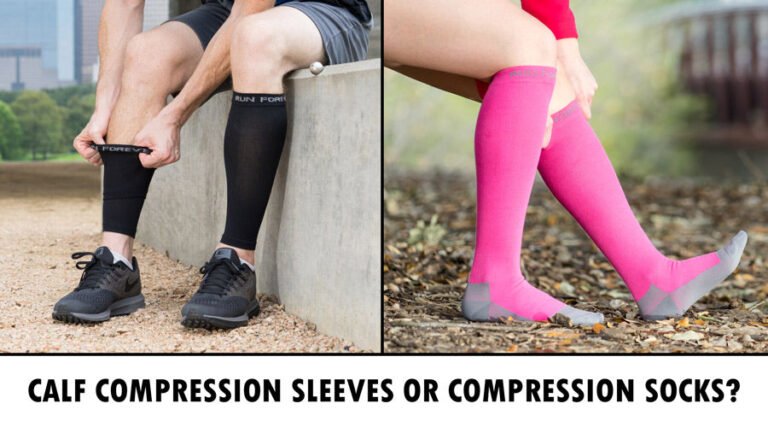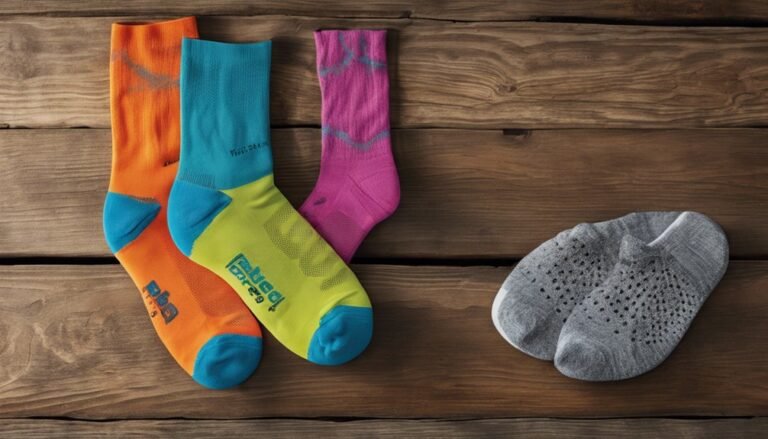Silk vs. Bamboo Socks: Which Is More Breathable?
When comparing silk and bamboo socks, bamboo clearly takes the lead in breathability. Bamboo fibers excel in moisture-wicking and airflow, keeping your feet dry and comfortable, especially during physical activities. Silk, while soft and luxurious, tends to retain some moisture and may not be as effective in high-sweat scenarios. If you prioritize breathability for warmer climates, bamboo is the way to go. Exploring the unique qualities of each material will further inform your choice.
Understanding Silk Fibers and Their Properties

When you explore the world of silk fibers, you'll find that their unique properties set them apart from other materials. Silk production involves the careful harvesting of silkworm cocoons, which yields a protein-based fiber known for its exceptional strength and luxurious feel. The fiber structure consists of tightly packed protein molecules, contributing to silk's natural sheen and softness. Additionally, silk fibers possess a remarkable ability to regulate temperature, making them comfortable in both warm and cool conditions. They also exhibit excellent moisture-wicking properties, drawing perspiration away from the skin. This combination of attributes not only enhances comfort but also elevates silk as a sought-after choice for garments, including socks, where breathability and softness are paramount.
Exploring Bamboo Fibers and Their Benefits
How does bamboo fiber stand out in the domain of textiles? Its unique properties stem from the process of bamboo cultivation and fiber extraction. Bamboo grows rapidly, requiring minimal water and pesticides, making it an eco-friendly choice. When harvested, the fibers undergo a chemical process to guarantee softness and durability, transforming the raw bamboo into a breathable textile. This process also highlights bamboo's natural antimicrobial properties, which can help reduce odor and enhance comfort. Additionally, the lightweight nature of bamboo fibers allows for excellent temperature regulation, promoting airflow. These characteristics make bamboo an appealing alternative for those seeking sustainable, comfortable clothing options that align with a desire for freedom and environmental responsibility.
Moisture-Wicking Abilities of Silk vs. Bamboo
When considering moisture-wicking abilities, silk and bamboo socks offer distinct advantages. Silk has natural moisture-wicking properties that can keep your feet dry, but it may not perform as effectively in high-sweat situations. In contrast, bamboo fibers are known for their superior moisture absorption and quick-drying capabilities, making them a strong contender for active wear.
Silk Moisture-Wicking Properties
The moisture-wicking properties of silk are often praised for their ability to regulate temperature and manage moisture effectively. Silk advantages include its natural protein structure, which allows it to absorb moisture without feeling wet. This means that when you wear silk socks, they can draw sweat away from your skin, keeping your feet dry and comfortable. Additionally, silk applications in various types of clothing highlight its versatility; many athletic and casual wear options incorporate silk for this very reason. Significantly, silk's lightweight nature contributes to breathability, making it a suitable choice for varying climates. Ultimately, if you're looking for a luxurious feel combined with effective moisture management, silk socks might be an excellent option for you.
Bamboo Moisture-Wicking Benefits
Bamboo socks can really stand out when it comes to moisture-wicking benefits, offering impressive advantages over traditional materials like silk. The unique structure of bamboo fiber allows it to absorb and evaporate moisture effectively, leading to enhanced bamboo sock performance. This means your feet stay drier and more comfortable, especially during physical activities.
| Bamboo Fiber Advantages | Silk Fiber Characteristics |
|---|---|
| Excellent moisture absorption | Moderate moisture retention |
| Antimicrobial properties | Limited breathability |
| Temperature regulation | Warm but less moisture-wicking |
| Eco-friendly production | Resource-intensive production |
Choosing bamboo socks can provide a better moisture-wicking experience, allowing you to enjoy freedom in movement without the discomfort of dampness. This makes bamboo a compelling choice for active lifestyles.
Temperature Regulation and Breathability
While both silk and bamboo socks offer unique benefits, their temperature regulation and breathability markedly differ, impacting your overall comfort. Silk, a natural fiber, has impressive thermal insulation properties, keeping your feet warm in cooler conditions while still allowing some breathability. This dual function makes silk suitable for varied temperatures. On the other hand, bamboo is renowned for its superior breathability, providing excellent moisture-wicking capabilities to keep your feet dry and cool. Its porous structure allows for better airflow, making it ideal for warmer climates. When it comes to breathable fabrics, bamboo clearly excels in breathability, while silk offers a balance of warmth and ventilation. Your choice will ultimately depend on your specific temperature regulation needs.
Comfort and Fit: How Each Material Performs

When considering comfort and fit, the moisture-wicking properties of bamboo socks can keep your feet drier compared to silk, which may retain moisture. Additionally, bamboo typically offers more stretch and flexibility, conforming better to the foot's shape, while silk can feel restrictive due to its lack of elasticity. Both materials also impact temperature regulation differently, influencing overall comfort during wear.
Moisture-Wicking Properties
The moisture-wicking properties of silk and bamboo socks greatly influence their comfort and fit, making them ideal choices for various activities. Silk naturally excels in moisture management, effectively absorbing sweat and drawing it away from your skin. This helps maintain a dry feel, especially during warm weather or intense workouts. Bamboo, on the other hand, also offers excellent sweat absorption, thanks to its porous structure. It not only draws moisture away but also has antibacterial properties, reducing odor. While both materials perform well in moisture control, silk might provide a more luxurious feel, whereas bamboo offers a more eco-friendly and sustainable option. Ultimately, your choice may depend on your activity level and personal preference for comfort in moisture-wicking performance.
Stretch and Flexibility
Although both silk and bamboo socks offer unique benefits, their stretch and flexibility greatly impact overall comfort and fit. Silk socks provide excellent stretch benefits, conforming closely to your foot's shape, which can enhance comfort during wear. Their fine fibers allow for a snug yet gentle fit, reducing the risk of irritation. Conversely, bamboo socks offer a different flexibility comparison. While they may not stretch as much as silk, they provide a looser fit that can be more forgiving for wider feet. This can make bamboo socks a comfortable choice for all-day wear, especially if you prefer less constriction. Ultimately, your choice may depend on whether you prioritize a snug fit or a more relaxed feel.
Temperature Regulation
While both silk and bamboo socks have their strengths, temperature regulation is an essential factor that influences overall comfort. Bamboo socks excel in this area, as their breathable fabrics allow for excellent moisture-wicking capabilities, keeping your feet cool and dry during warmer months. The natural fibers in bamboo provide a more effective temperature regulation, adapting to your body's needs. On the other hand, silk socks, while luxurious, tend to retain heat, which may not be ideal for everyone. Their lightweight nature offers breathability, but it doesn't match bamboo's moisture management. Ultimately, if you're looking for socks that keep your feet comfortable through varying temperatures, bamboo is the superior choice, ensuring a more enjoyable wearing experience.
Durability and Care: Longevity of Silk and Bamboo Socks
When considering the longevity of silk and bamboo socks, it's important to evaluate their material properties and care requirements. Silk, while luxurious, has lower durability factors; it tends to wear out faster, especially with frequent washing. To maximize its lifespan, follow gentle care instructions: hand wash in cold water and avoid harsh detergents. On the other hand, bamboo socks boast greater durability due to their strong fibers. They resist wear and tear better than silk, making them a practical choice for everyday use. Care instructions for bamboo are straightforward; machine wash on a gentle cycle and air dry to maintain their quality. Ultimately, your choice will depend on how you weigh comfort against durability and care effort.
Eco-Friendliness and Sustainability Considerations
As consumers increasingly prioritize eco-friendliness, the sustainability of sock materials becomes a significant consideration. Bamboo socks often excel in this area due to their rapid growth and low environmental impact. The process of sustainable sourcing means bamboo can be harvested without damaging ecosystems, and many brands emphasize eco-friendly production methods. On the other hand, silk, while luxurious, typically requires more resources and energy, and its production can involve harmful practices. If you're looking for a greener option, bamboo might align better with your values. Ultimately, choosing socks made from sustainably sourced materials can contribute to a more eco-conscious lifestyle, allowing you to enjoy comfort without compromising your commitment to the environment.
Frequently Asked Questions
Can I Wear Bamboo Socks During Athletic Activities?
You can wear bamboo socks during athletic activities, but consider their durability. While they offer comfort, they may not withstand intense use as well as other materials, potentially impacting your overall athletic performance in the long run.
Are Silk Socks Suitable for Sensitive Skin?
Imagine a gentle breeze caressing your skin; silk's properties create a soft, soothing touch. This can minimize skin irritation for sensitive individuals, offering a luxurious experience that allows you to embrace comfort without worry.
How Do Bamboo and Silk Socks Compare in Terms of Odor Resistance?
When comparing odor resistance in bamboo and silk socks, bamboo typically offers better odor control due to its natural antimicrobial properties. Silk, while luxurious, may retain odors more, making bamboo the preferable choice for freshness.
Can Silk or Bamboo Socks Be Machine Washed?
When it comes to fabric care, you'll find that both silk and bamboo socks require gentle washing instructions. While machine washing's tempting, hand washing's often the safer route to maintain their quality and longevity.
Do Bamboo Socks Have Any Natural Antibacterial Properties?
Bamboo socks possess natural antibacterial properties, thanks to bamboo benefits. This means they can help reduce odors and keep your feet fresher for longer. Choosing them might enhance your comfort and hygiene considerably.







